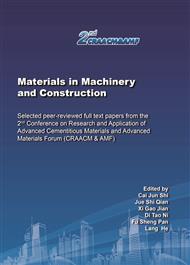[1]
J.R. Conner, Chemical Fixation and Solidification of Hazardous Waste., Van Nostrand Reinhold, New York. 1990. 59-75.
Google Scholar
[2]
F.P Glasser, Fundamental aspects of cement solidification and stabilisation., J. Hazard. Mater. 52 (1997) 151–170.
Google Scholar
[3]
P.G Baker, P.L Bishop, Prediction of metal leaching rates from solidi-fied / stabilized wastes using shrinking unreacted core leaching procedure., J. Hazard. Mater. 52 (1997) 311–333.
DOI: 10.1016/s0304-3894(96)01814-6
Google Scholar
[4]
C.D Hills, L. Koe, C.J Sollars, et al, Early heat of hydration during the solidification of a metal plating sludge, Cement Concrete Res. 22 (1992)822–832.
DOI: 10.1016/0008-8846(92)90106-6
Google Scholar
[5]
T.S. Anirudhan, P.G. Radhakrishnan, Kinetic and equilibrium modelling of Cadmium (II) ions sorption onto polymerized tamarind fruit shell, Desalination. 249 (2009) 1298-1307.
DOI: 10.1016/j.desal.2009.06.028
Google Scholar
[6]
C. Tashiro, J. Oba, The effects of Cr2O3, Cu(OH)2, ZnO, PbO on the compressive strength and the hydrates of the hardened C3A paste, Cement Concrete Res. 9 (1979) 253–258.
DOI: 10.1016/0008-8846(79)90032-2
Google Scholar
[7]
C.F. Lin, T.H, Huang. Leaching characteristics of a model solidification stabilization system—tricalcium silicate and copper-oxide, J. Hazard. Mater.36 (1994) 305–319.
DOI: 10.1016/0304-3894(94)85022-4
Google Scholar
[8]
D. Stephan, H. Maleki, D. Knofel, et al, Influence of Cr, Ni, and Zn on the properties of pure clinker phases Part II. C3A and C4AF, Cement Concrete Res. 19 (1999) 651–657.
DOI: 10.1016/s0008-8846(99)00008-3
Google Scholar
[9]
H.Y. Li, Z. Ding, F. Xing, et al, Effect of fly ash and slag on hydration heat evolution of cement. Concrete, 2008, (10): 54-57.
Google Scholar


